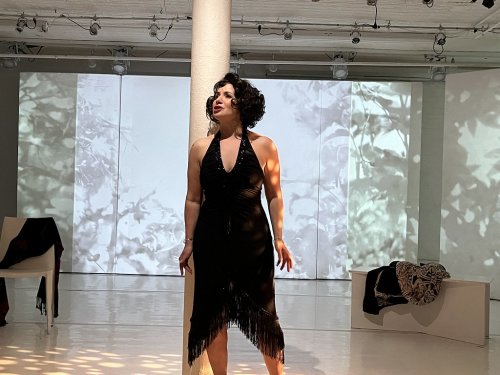Garden of Alla: The Alla Nazimova Story
A fascinating look at the career of an almost forgotten theater and silent screen star.

Romy Nordlinger in a scene from “Garden of Alla: The Alla Nazimova Story” at TheaterLab (Photo credit: Lorca Peress)
[avatar user=”Joel Benjamin” size=”96″ align=”left”] Joel Benjamin, Critic[/avatar]
A century ago the Russian-born actress, Alla Nazimova (1879–1945, née Marem-Ides Leventon) was an internationally famous silent movie star. Her personal life was as colorful as her films, the most famous of which are Camille and Salomé, both hothouse, sexually ambivalent versions of those classic stories.
Romy Nordlinger has written and is performing the monodrama, Garden of Alla: The Alla Nazimova Story, at the TheaterLab. Directed by Lorca Peress, Garden of Alla gives us this eccentrically talented artist up close and personal.
Nordlinger has a history of portraying Nazimova and has honed her interpretation to the point that it fits her like a second skin, helped by Peress’ sense of pacing and stagecraft.
The play is also invigorated by video images designed by Adam Burns illustrating all the people and places in an adventurous, sensual life. Properly moody and period-suggestive music and sound is by Nick T. Moore.

Romy Nordlinger in front of her memorial in Forest Lawn in a scene from “Garden of Alla: The Alla Nazimova Story” at TheaterLab (Photo credit: Lorca Peress)
After a minute or two of vintage film bits—excerpts from Salomé, sounds of an auctioneer, period photographs—Nazimova enters and shouts “Cut!” to stop the videos only to have them rewound so that she could explicate each image.
She understands that her legacy emanates mostly from her Hollywood sojourn even though she had had a brilliant acting career first in Russia as a student of Constantin Stanislavki (later the source of The Method, a distortion of his theories of acting), then in Europe and finally on Broadway where she was lauded for her interpretations of Chekhov, Ibsen and other serious playwrights. (Dorothy Parker declared Nazimova’s Hedda Gabler to be definitive.)
But it was in Hollywood where her over-the-top films and bisexual lifestyle partially eclipsed her brilliance. As if to prove this, she enters in a copy of the long, bejeweled cape she wore as Salomé. Worn over an elegant black dress, this gives her an image far more reminiscent of that period than her New York theater work.
Displaying a sardonic sense of humor, she begins her story at the end: Forest Lawn Cemetery where her fellow Hollywood stars are buried. She even jokes that she would have loved to have been located next to Carole Lombard, except for the fact that her “pit bull” lover, Clark Gable, lies right next to Lombard! Alla is clearly referring to her own lesbianism.

Romy Nordlinger before a photo of herself as Camille in a scene from “Garden of Alla: The Alla Nazimova Story” at TheaterLab (Photo credit: Lorca Peress)
Her story begins in Yalta, the Crimea where she was born in 1879 into a middle class Jewish family. Her father was abusive to both her and her mother who left when Alla was young. This Garden of Alla Alla pulls no punches in her raw descriptions of her childhood traumas.
Her only relief came with playing the violin. Her performances on that instrument brought her her first taste of being admired by masses of people. Even that set her father off on sadistic tirades. Her childhood became a series of foster homes where she had to hide her Jewishness. Along the way, she changed her name.
Her early life was a toxic mixture of hiding her identity, selling herself to survive, being kept and finally emerging from the darkness to become an acolyte of Stanislavski, the first step in what was to be an illustrious career as an actress. She quotes Stanislavski and Chekhov with respect and admiration.
Nazimova, although married to several men, sometimes without benefit of divorcing previous mates, had affairs with Eva LeGallienne, Natacha Rambova (Rudolph Valentino’s wife, born Winifred Shaughnessy) and, the love of her life, Glesca Marshall.

Romy Nordlinger in front of her star on the Hollywood Walk of Fame ina scene from “Garden of Alla: The Alla Nazimova Story” at TheaterLab (Photo credit: Lorca Peress)
Nordlinger’s writing has bite, bitchiness, humor and pathos all brought to life via her nuanced, yet grand acting. Her stories of her Hollywood days, in particular, are fascinating, although her tales of coming to New York City with her lover and setting up a short-lived theater company vie with her colorful film days. Along the way, she impersonates a number of other characters such as her father, Stanislavski and several of her husbands, again abetted by Burns’ on screen images.
This is a fine recreation of a sadly forgotten personality. Hopefully, Nordlinger’s efforts will result in a resurgence of interest in Nazimova’s life. (There are only two later films which immortalize Nazimova’s voice.)
Before and after the play, a trio of jazz musicians, Les Trois Gitans, entertains the audience with lively interpretations of standards from the great American Songbook. The three talented musicians relaxed the audience and, in addition, were absolutely adorable.
Garden of Alla: The Alla Nazimova Story (through June 25, 2022)
TheaterLab, 357 West 36th St., 3rd Floor, in Manhattan
For tickets, call 212-929-2545 or visit http://www.theaterlabnyc.com
Running time: 90 minute without an intermission






Leave a comment